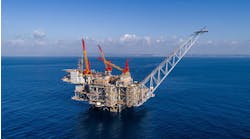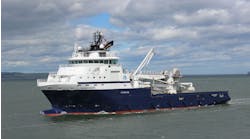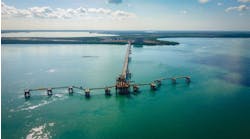Adding molasses to or removing sulfates from injected seawater
Seawater injection into reservoirs, even with chemical treatment, offers an often unpredictable mix of results for producers. Generally, the injected fluids or gases boost flow from production wells, at least initially, but, after a short burst lasting 1-2 years, the reservoir pressure often collapses unexpectedly and production ceases. The reason is complex, and why microbiologists are joining teams of reservoir specialists trying to characterize reservoir fluids and the impact of injected chemicals.A typical disaster in enhanced recovery science is to inject seawater in which sulfates are almost always resident into a sweet reservoir, have it turn sour, and begin producing quantities of hydrogen sulfide along with oil and gas. Hydrogen sulfide production must be accounted for in the design of production piping and removed before production is routed to a pipeline. The bacteria that reduce sulfates to sulfides are among organisms having the highest tolerance for extreme reservoir conditions.
Fluids resident in an oil and gas reservoir are in a chemical equilibrium of sorts, and injected fluids will not only produce a chemical reaction with reservoir fluids, but introduce nutrients to a vast range of resident bacteria in the reservoir. What is truly remarkable about reservoir bacteria is that they can withstand great heat (up to 175 degrees C), pressure (depths up to 4 km), anaerobic conditions, high salt conditions (NaCl up to 30%), wide pH insensitivity (1 to 11), and can live in a dormant state for long periods of time.
Such bacterial colonies can be activated by ingredients in injected flows, producing a biopolymer attachment film and digestive products that block rock and sand pores, reducing permeability. On the other hand, bacteria produce acids (acetic and lactic acid, which dissolve rock surfaces), gases (carbon dioxide, methane, hydrogen), and surfactants that can greatly assist reservoir flow.
Interestingly, the priming of injection fluids with 2% molasses results in the production of high levels of butyric acid, carbon dioxide, and hydrogen, which together suppress the growth of sulfate reducing bacteria and promote the growth of methane-generating bacteria.
Bacteria can be found in almost any dry or wet rock formation at depths. They live by consuming various compounds of hydrogen, water, and carbon dioxide, most often as dilute hydrocarbons. When nutrients are not present, they simply shift to a dormant stage.
Scientists at the University of Exeter in the UK are studying a potentially serious problem for reservoir contamination. When produced water is dumped into the sea, colonies of temperature-resistant sulfate reducing bacteria can be introduced into the ocean environment. This is not a problem for the ocean because the bacteria go dormant. However, if they are picked up by injection pumps and introduced to a reservoir which had no such bacteria before, the consequences for the reservoir could be costly or even terminal, since the production system may not have been equipped to handle hydrogen sulfide. Sulfate reducing bacteria are resistant to biocide treatment, either in the injection system or down in the reservoir.
It is critical that scientists are able to properly characterize fluids across the entire reservoir, so that injected fluids may not create a chain of chemical or biological reactions that could prematurely reduce permeability or commence the production of hydrogen sulfide.
Reference: Bass, C., Lappin-Scott, H., "The Bad Guys and the Good Guys in Petroleum Microbiology," Oilfield Review, Spring, 1997. Monastersky, R., "Deep dwellers: Microbes thrive far below ground," Science News, March 29, 1997.
Laser/blown gas simulated for welding at 500-meter depths
When water depths exceed 300 meters, water pressure creates too many weld stability problems for conventional arc welding. In addition, welding in greater water depths must be carried out remotely because it exceeds human diver capabilities. This is why companies attempting joint or equipment mating at great water depths usually resort to specifying some type of forging or bolting process in the design stage. However, the need for remediation or equipment additions is forcing the industry to re-investigate alternatives.With these limitations in mind, the University of Aberdeen Department of Engineering has been conducting simulations under actual pressures of a high power carbon dioxide laser combined with an argon gas jet blown horizontally across the weld to remove plasma. The process has been effective lately in achieving weld penetration and quality, although early trials either failed to achieve weld penetration or blew the weld apart.
After trials of several systems, researchers developed a 5kW carbon dioxide laser mounted on a work platform. A camera mounted on a window facilitated remote manipulation of the work piece and weld. A minimum coaxial gas was introduced to prevent water spatter on the optics.
Critical to improving weld quality was dealing with large volumes of plasma at the weld site. Plasma is critical to the operation because it vaporizes the surrounding water and creates a critical dry region. However, when the high-pressure volumes overwhelm the work area, they tend to absorb the laser energy and diffuse the beam. Pumping more helium into the work area only increases the volume of ionized gas. The solution was to blow a heavy gas, argon, across the weld to displace the plasma. The university is continuing research on the process with actual trials planned sometime in the future.
Optical multiplexing expands capacity
Optical transmission cables can now be made even smaller or carry more bandwidth with wave length division multiplexing. Researchers are now able to split an optical beam into as many as 100 separate colors, each carrying as much data as the original signal. Major telephone and communications firms such as AT&T, Sprint, and MCI are exploiting the technology now, but the process will trickle down into specific applications when equipment size is reduced.609 Tiltrotor
Bell Helicopter and Boeing Helicopters are planning first customer deliveries in 2001 of their 609 tiltrotor, a new aircraft that can land vertically, has a range of 750 miles, a cruising speed of 275 knots, and an operating ceiling of 25,000 ft. The aircraft is expected to eventually replace the helicopter on longer range flights.Copyright 1997 Oil & Gas Journal. All Rights Reserved.


